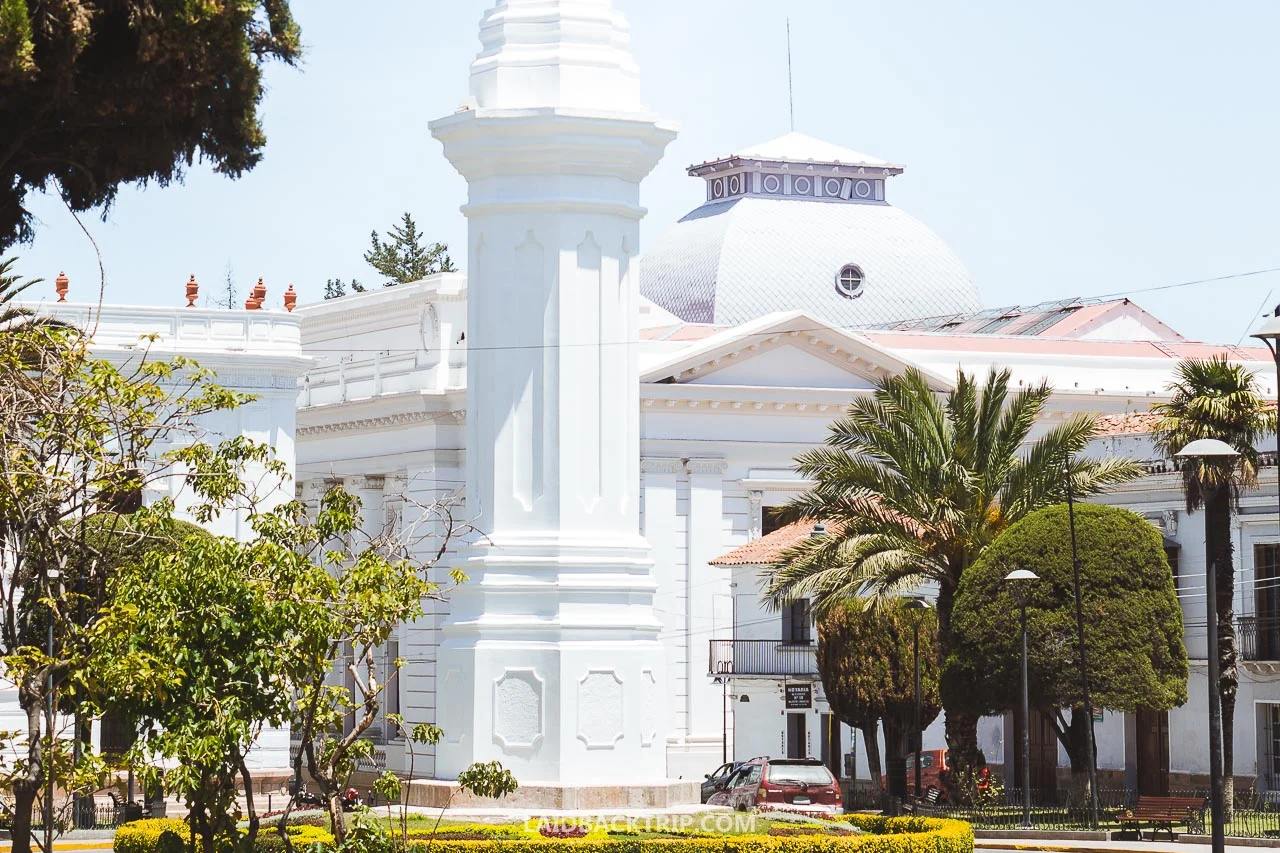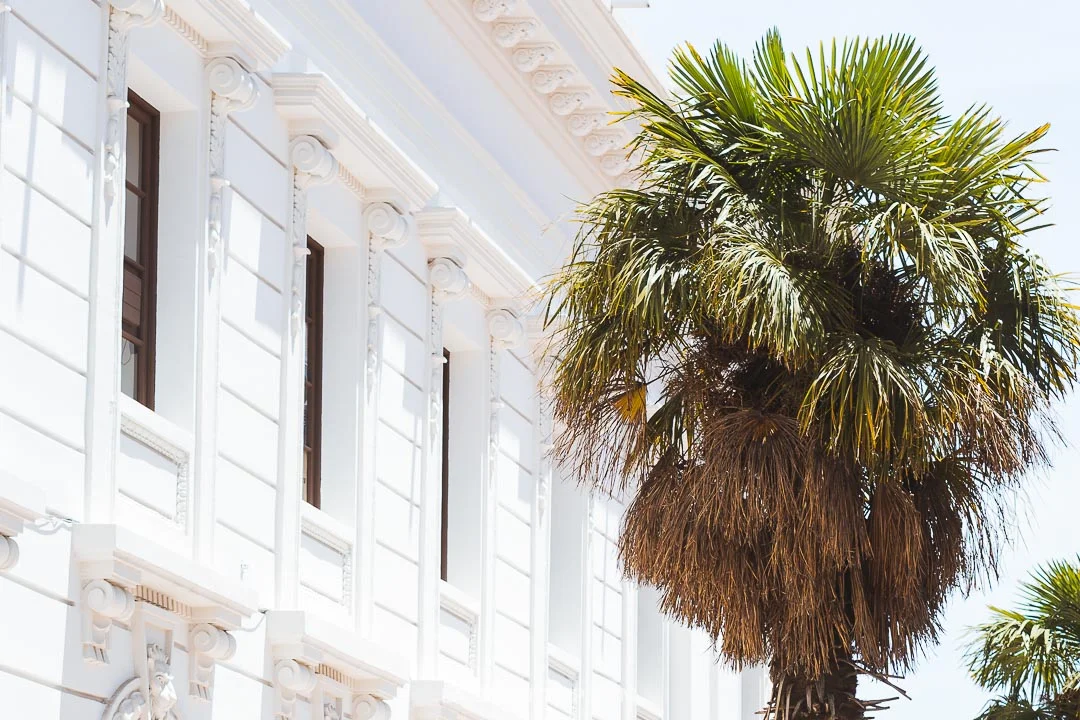A Quick Guide to Sucre: Bolivia's White City
Sucre is the capital of Bolivia and thanks to whitewashed colonial buildings is nicknamed the White City. Although the UNESCO listed Sucre doesn't boast with plenty of things to see and do, it will be a pleasant stop on your travel itinerary. Check out our quick guide to Sucre, to get an idea of what are the attractions and must-visit places.
Many travelers are drawn to visit Sucre only after seeing one single photo of white colonial buildings, white churches, high bell towers, romantic courtyards inviting to relax, red-tiled rooftop terraces, and picturesque hills surrounding the city. One would say that the capital city of Bolivia must be on every backpacker's itinerary.
Although Sucre is for sure not unknown among travelers (it is actually one of the most popular cities in South America where you can learn Spanish in one of many schools for reasonable prices) it lacks obvious tourist attractions, and the typical visitor of Sucre is either a long-term traveler or a hopeless romantic soul.
To enjoy amazing rooftop views, shopping on the central market, walking streets in the historical center, it is enough to stay in Sucre only one day. But if you want to unwind, savor the laidback atmosphere and take it easy, you might easily lose track of time here, and find yourself in Sucre even weeks later.
We must admit that we arrived in Sucre after approximately six months of non-stop traveling when Martin rolled his eyes every time he heard the expression 'pretty colonial town', and me, after another overnight bus was not super excited either. Buses in Bolivia were pretty terrible, and on this particular bus from La Paz to Sucre, we had a nasty fight with money collector, because we paid extra money to sit on the first floor, but the company switched buses, and they assigned us to the second floor with people who paid half the price. Normally, we wouldn't mind, but as we paid double only to sit downstairs for safety reasons, we had quite a long fight until we won the place we paid for.
Long story short, we arrived in Sucre, not in our best mood, so we decided only to walk around without any must-visit places in mind, and it was probably the best we could do. We had breakfast on the main square Plaza 25 de Mayo where we admired the architecture of buildings around such as the Cathedral, State Government Building or Liberty House, then we aimlessly wandered around the historical center and later ended up in a park where we took a nap for a while.
Although Sucre is the constitutional capital of the country (the government seat is in La Paz), when walking the streets in the historical center, we had a feeling we are in a small town somewhere in the mountains. Ladies in their traditional dress and hats strolled the streets, men were having their siesta, and nothing suggested this is a 300 000 city.
Because our visit to Sucre was affected by our momentary burnout, we feel like we should give Sucre another try one day in the future.
Our tip: We arrived in Sucre on Sunday, and the city was dead - it was a challenge to find a restaurant open, so try to arrive between Monday and Saturday in case you prefer more lively atmosphere.
Also, Bolivia as a country often struggles with strikes and protests, which usually happen here in Sucre or in La Paz (roadblocks are common). Read local news when traveling.
THINGS TO SEE AND DO IN SUCRE
The city center of Sucre is compact, so you will be able to cover all its corners on foot easily.
CENTRAL MARKET
No matter where we travel, we always try to visit the market. Sometimes it is a disappointment as markets often turn into tourist museums with overpriced exotic fruit, but the market in Sucre is worth visiting.
SPANISH SCHOOL
We met many travelers who studied Spanish for a week or longer in Sucre (another popular destination is Antigua in Guatemala). The main reason is that Sucre is considerably cheap, lessons usually come with accommodation in local families, and the relaxed atmosphere is alluring.
Travel Insurance
We never leave home without travel insurance that was designed to cover our expenses if something goes wrong during the trip.
Travel insurance protects against theft, flight delays, injury, illness, cancellations, and much more.
World Nomads provides travel insurance for travelers to cover their trip essentials, including sports and adventure activities.
SafetyWing is affordable travel insurance for backpackers, long-term travelers, and digital nomads.
Travel smarter and safer!
PLAZA 25 DE MAYO
The historical center of Sucre is the reason why was the city listed on the UNESCO World Heritage List in 1991. The plaza is where local people meet, where you can dine in the best restaurants in the city, and where you can admire the beautiful architecture.
CONVENTO DE SAN FELIPE NERI
The most famous building in Sucre is the former monastery where you can walk around the lovely courtyard, and you can even climb to the roof to get lovely views of the city.
PARQUE BOLIVAR
This park is the largest in Sucre, and also the most popular among locals who come here often, especially on weekends.
WHERE TO STAY IN SUCRE
The city of Sucre has an uncountable number of pretty colonial houses with private courtyards, and the best thing is that you can stay in one of them for a much lower price than anywhere else in the world. We've handpicked three best places to stay in Sucre for every budget.
Budget | Family Hostel - The name says it all. A budget-friendly family hostel has a great atmosphere, clean rooms, both private and dormitories, and a complimentary breakfast.
Mid-range | Mi Pueblo Samary Hotel Boutique - A beautiful oasis set in a colonial mansion has an outstanding terrace overlooking the white city.
Luxury | Roles Hotel - Only steps away from the historical center lies this excellent hotel with spotless beautifully appointed rooms and spa center.
Alternatively, search for your accommodation via Hostelworld.
WHAT TO PACK FOR SUCRE
Like most of the other cities in Bolivia, Sucre lies in a high altitude, 2800 meters above sea level. The temperature in Sucre is pleasant all year round, but it can be cold a couple of weeks in winter, and also nights and mornings can be a bit chilly.
Here are five essential things you should pack when traveling to Sucre.
Fleece Jacket for Him & for Her | For mornings or evenings, you will find an extra warm layer handy.
Jeans for Him & for Her | Even when traveling for longer, a pair of jeans should have a place in your backpack.
Shorts for Him & for Her | We visited Sucre in summer, and it was hot all day long, so shorts came in handy.
Sunscreen | The sun is strong in Bolivia. We forget to apply it when in Sucre, and after an hour we decided we have to go back for sunscreen otherwise we would have sunburnt.
SteriPen | Our popular travel gadget is water purifier so we do not have to buy plastic bottles.
We've also written an in-depth South America packing list where you will find more useful tips and advice on what to pack.
HOW TO GET TO SUCRE
Sucre is the capital city of Bolivia, so to get there you can use either bus transport or take a flight.
We traveled around South and Central America mostly by bus, and the service was undoubtedly the worst here in Bolivia. Either way, we were always able to get from one place to another. We traveled by overnight bus from La Paz to Sucre, and then by another overnight bus to Tupiza. You can also take a direct bus from Sucre to Uyuni.
When traveling to Sucre by plane, you will lend at Alcantari International Airport, which is 30 kilometers from the center, so you will need to take a taxi. The ride takes anything between forty minutes and an hour.
Travel Resources
Here you can find links to all the travel resources we use and which you might find helpful when planning your next holiday.
Accommodation: When looking for accommodation, we usually search hotels via Booking.com or Hostelworld.
Tours: Although we love to travel independently, some places are better to visit with a guided tour.
We prefer GetYourGuide for its easy-to-use interface and solid reputation. Another great alternative is Viator.
Rental Cars: When going on a road trip, we always use Rentalcars.com, a reliable site for booking a rental car in advance.
Flight Tickets: When looking for flight tickets, you can search Skyscanner to find the best price.
Travel Insurance: World Nomads and SafetyWing cover against risks of travel.








